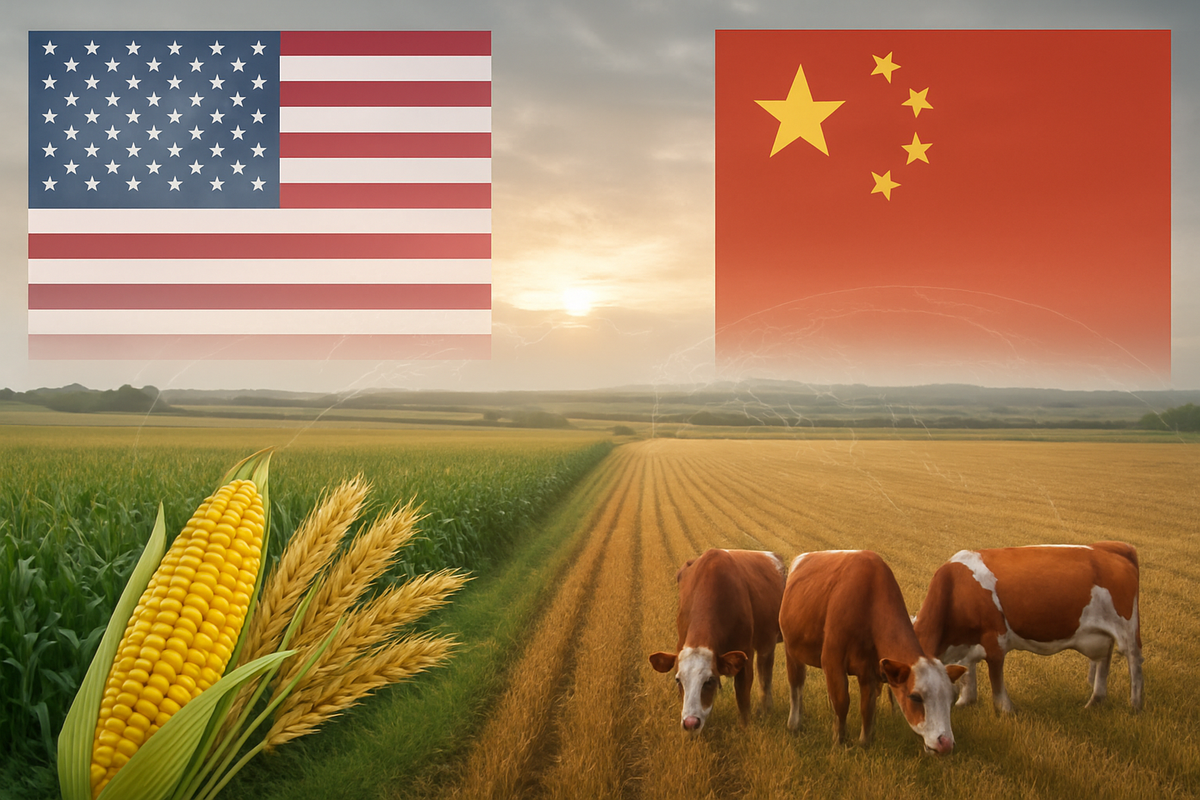U.S.-China Trade Deal: A Cautious Optimism for Global Agricultural Markets Beyond Soybeans – FinancialContent

Report on the U.S.-China Agricultural Trade Framework and its Implications for Sustainable Development Goals
Executive Summary
A new agricultural trade framework announced on October 30, 2025, between the United States and China presents significant implications for the global pursuit of the Sustainable Development Goals (SDGs). This report analyzes the agreement’s potential to impact global food security (SDG 2), promote sustainable economic growth (SDG 8), and strengthen global partnerships (SDG 17). While the framework offers a pathway to stabilize volatile agricultural markets, its long-term success in advancing the SDGs depends on consistent implementation and the resolution of underlying trade barriers.
Analysis of the Framework’s Impact on SDG 2: Zero Hunger
The agreement directly addresses key targets within SDG 2 by seeking to ensure stable food supplies and support agricultural producers. The de-escalation of trade tensions is a critical step toward correcting and preventing trade restrictions and distortions in world agricultural markets.
Stabilizing Global Food Supply Chains
The framework’s core commitment is intended to enhance food security, particularly for China, a nation with significant food demand. By creating a more predictable trade environment, the agreement contributes to the stability of global food markets, which is essential for achieving Zero Hunger.
- Soybean Commitment: China’s pledge to purchase 25 million metric tons of U.S. soybeans annually for three years provides a substantial and predictable supply of a key food and feed commodity.
- Broader Commodity Impact: The commitment to purchase “other agricultural products” is expected to stabilize markets for corn, wheat, and sorghum, further contributing to global food availability.
- Market Volatility Reduction: A functional trade relationship between the world’s two largest economies can temper global commodity price volatility, benefiting both producers and consumers worldwide and ensuring access to safe, nutritious, and sufficient food.
Support for Agricultural Producers
The economic viability of farmers is a cornerstone of SDG 2. The framework has the potential to improve the livelihoods of U.S. agricultural producers, though benefits are not distributed evenly across all sectors.
- Direct Beneficiaries: U.S. soybean and grain farmers are positioned to gain from increased demand and price stability, which supports their economic sustainability.
- Sectors Facing Uncertainty: The U.S. pork, beef, and dairy sectors, which have faced prohibitive tariffs, require specific tariff rollbacks to realize benefits. Without these, producers in these sectors continue to face market access challenges, hindering progress toward sustainable incomes.
Implications for SDG 8: Decent Work and Economic Growth
The trade framework influences economic growth by impacting agricultural productivity, trade volumes, and employment in related sectors. A stable trade environment fosters the conditions necessary for sustained and inclusive economic growth.
Economic Opportunities and Challenges
The agreement creates distinct economic outcomes for various stakeholders, highlighting the need for policies that ensure inclusive growth.
- Sectors with Growth Potential:
- Agriculture: U.S. soybean and grain sectors are expected to see improved profitability.
- Support Industries: Agricultural equipment manufacturers (e.g., Deere & Company) and logistics companies stand to benefit from increased trade activity.
- Sectors Requiring Policy Support:
- Meat and Dairy: U.S. pork, beef, and dairy exporters (e.g., Tyson Foods) face continued economic pressure without the removal of high tariffs. Their ability to contribute to economic growth remains constrained.
- Biofuels: The U.S. ethanol sector’s access to the Chinese market remains limited, impacting a key value-added agricultural industry.
Impact on SDG 17: Partnerships for the Goals and SDG 12: Responsible Consumption and Production
This bilateral framework serves as a critical test for global trade partnerships (SDG 17) and has far-reaching consequences for global production and consumption patterns (SDG 12).
Strengthening Global Trade Partnerships
The agreement is a significant act of bilateral cooperation aimed at stabilizing a crucial economic relationship. Its success or failure will influence broader global trade dynamics.
- Bilateral Cooperation: The framework represents a mutual effort to de-escalate tensions and prevent further economic damage, aligning with the principles of SDG 17.
- Impact on Global Competitors: The shift in trade flows will affect other agricultural exporting nations like Brazil, Argentina, and Australia, potentially requiring them to adapt their production and trade strategies. This highlights the interconnectedness of global partnerships.
- Regulatory Alignment: A key aspect of the partnership involves addressing non-tariff barriers (NTBs), such as sanitary and phytosanitary measures. Streamlining these regulations is essential for fostering an open, non-discriminatory, and equitable multilateral trading system.
Promoting Sustainable and Resilient Supply Chains
The trade tensions of recent years have exposed the vulnerability of global supply chains. The new framework and the strategic responses to it can encourage more responsible and resilient production systems.
- Supply Chain Diversification: The recent period of uncertainty has driven China to diversify its agricultural sources, a trend that is likely to continue. This promotes a more resilient global food system, reducing dependency on a single supplier.
- Strategic Adaptation: Businesses are encouraged to adopt strategies that enhance supply chain resilience, such as market diversification and investment in technology, which aligns with the goal of sustainable production.
- Future Considerations: The integration of sustainability standards, such as those related to climate-resilient agriculture, into future trade agreements could further advance SDG 12.
Conclusion and Strategic Outlook
The U.S.-China agricultural trade framework is a foundational step toward restoring stability in global food markets, with direct relevance to achieving SDGs 2, 8, 12, and 17. However, cautious vigilance is required.
Key Monitoring Points for Sustainable Development Progress
- Implementation and Data Verification: Monitor confirmed purchase data to ensure commitments translate into tangible trade flows that support food security and economic growth.
- Durability of the Agreement: Assess the stability of the truce, as any reversal would undermine progress toward the SDGs.
- Negotiation on Structural Barriers: Track progress in addressing non-tariff barriers and prohibitive tariffs on goods like pork and dairy, which is crucial for ensuring inclusive benefits.
- Presidential Visit (April 2026): The outcome of this diplomatic event will be a key indicator of the long-term viability of the partnership.
Ultimately, the framework’s success will be measured by its ability to foster a predictable trade environment that supports farmer livelihoods, ensures global food security, and promotes sustainable, resilient supply chains for the future.
Analysis of Sustainable Development Goals in the Article
1. Which SDGs are addressed or connected to the issues highlighted in the article?
-
SDG 2: Zero Hunger
This goal is central to the article, which focuses on international agricultural trade, food supply chains, and global food security. The trade agreement between the U.S. and China directly impacts the availability and stability of food supplies for China’s large population and influences global commodity markets. The article explicitly states, “China’s insatiable demand for food… makes a stable U.S.-China agricultural trade relationship paramount for global food security.”
-
SDG 8: Decent Work and Economic Growth
The article extensively discusses the economic implications of the trade deal on the agricultural sector. It details how the agreement affects the profitability and economic stability of U.S. farmers, agricultural companies (like ADM, Bunge, Tyson Foods), and related industries such as equipment manufacturing and logistics. The potential for “improved farmer income” and increased sales for companies like Deere & Company directly relates to economic growth and the livelihoods of those in the agricultural sector.
-
SDG 17: Partnerships for the Goals
The entire article is about a bilateral trade framework between two major global powers, the United States and China. This agreement is a form of international partnership aimed at stabilizing global markets, reducing trade tensions, and ensuring a more predictable flow of essential goods. The article notes the framework’s goal is to “foster greater trust and cooperation, potentially acting as a stabilizing force in broader U.S.-China geopolitical relations,” which embodies the spirit of SDG 17.
2. What specific targets under those SDGs can be identified based on the article’s content?
-
Under SDG 2 (Zero Hunger):
- Target 2.b: Correct and prevent trade restrictions and distortions in world agricultural markets. The article is fundamentally about this target. It discusses the de-escalation of a trade war marked by “tariffs and unfulfilled promises.” The new framework aims to dismantle trade barriers, including “prohibitive tariffs” on pork and beef (some reaching “more than 90% decline” in exports) and dairy (up to 125%), as well as addressing “non-tariff barriers (NTBs), such as cumbersome sanitary and phytosanitary (SPS) measures.”
- Target 2.c: Adopt measures to ensure the proper functioning of food commodity markets and their derivatives and facilitate timely access to market information, including on food reserves, in order to help limit extreme food price volatility. The agreement’s objective to create a “more stable and predictable trading environment” and “temper volatility” in global markets directly aligns with this target. The specific purchase commitments for soybeans are a measure designed to ensure market functioning and reduce price uncertainty.
-
Under SDG 8 (Decent Work and Economic Growth):
- Target 8.1: Sustain per capita economic growth in accordance with national circumstances. The article highlights how the trade deal is expected to provide a “significant boost to demand and price stability” for U.S. soybean farmers and lead to “improved agricultural profitability.” This directly contributes to the economic well-being and growth of the U.S. agricultural sector.
- Target 8.2: Achieve higher levels of economic productivity through diversification, technological upgrading and innovation. The article points to the need for strategic adaptation, including “market diversification” into other regions, “agtech adoption,” and strengthening “intellectual property rights (IPR) protections for agricultural biotechnology and seeds,” all of which are drivers of economic productivity and innovation.
-
Under SDG 17 (Partnerships for the Goals):
- Target 17.10: Promote a universal, rules-based, open, non-discriminatory and equitable multilateral trading system under the World Trade Organization. The article mentions that “China’s WTO accession in 2001… stands as a foundational event” and that the new framework operates “within that established global trading system, seeking to refine and stabilize the bilateral relationship within it.”
- Target 17.11: Significantly increase the exports of developing countries. While the focus is on the U.S., the article analyzes the ripple effects on competitors, noting that countries like “Brazil and Argentina, which significantly increased their agricultural exports to China” during the trade friction, may now face reduced market share. This highlights the interconnectedness of global trade and the impact of bilateral agreements on other exporting nations, including developing ones.
3. Are there any indicators mentioned or implied in the article that can be used to measure progress towards the identified targets?
-
Indicators for SDG 2 Targets:
- Agricultural export subsidies and tariffs: The article provides specific tariff levels that can be monitored, such as the “tariffs as high as 125%” on U.S. dairy products and the “23% import tariff on U.S. soybeans.” A reduction or elimination of these tariffs would be a direct indicator of progress towards Target 2.b.
- Volume of commodity purchases: The article gives concrete figures that serve as clear indicators. The commitment for China to purchase “12 million metric tons immediately and 25 million metric tons annually for the next three years” of soybeans is a measurable indicator for Target 2.c. The article also suggests monitoring “confirmed purchase data to see if China’s commitments materialize into concrete export volumes.”
- Food price volatility: The article mentions that initial market reactions included an “uptick” in grain futures and that the deal could “temper volatility.” Monitoring commodity price indices for soybeans, corn, and wheat would serve as an indicator of market stability.
-
Indicators for SDG 8 Targets:
- Growth rate of real GDP per capita: While not directly stated, progress can be implied through indicators of sectoral economic health, such as “improved farmer income,” “increased sales” for agricultural equipment manufacturers, and the overall profitability of the U.S. agricultural sector.
- Agricultural productivity: The article implies this can be measured by the adoption of agtech and the protection of IPR for agricultural biotechnology, which would lead to higher yields and efficiency. The success of U.S. producers in reclaiming market share would also be an indirect indicator of their competitive productivity.
-
Indicators for SDG 17 Targets:
- Worldwide weighted tariff-average: The article’s focus on reducing specific U.S.-China tariffs contributes to this global indicator. The success of the deal in rolling back tariffs on pork, beef, and dairy would be a measurable component.
- Share of global exports: The article discusses the potential for the U.S. to “regain some market share lost to competitors” and the corresponding risk of a “reduction in their market share” for countries like Brazil and Argentina. Tracking the export market share of these countries in the Chinese market is a clear indicator.
4. Table of SDGs, Targets, and Indicators
| SDGs | Targets | Indicators Identified in the Article |
|---|---|---|
| SDG 2: Zero Hunger |
2.b: Correct and prevent trade restrictions and distortions in world agricultural markets.
2.c: Adopt measures to ensure the proper functioning of food commodity markets… to help limit extreme food price volatility. |
– Reduction/removal of specific tariffs (e.g., 125% on dairy, 23% on soybeans). – Dismantling of non-tariff barriers (NTBs) like SPS measures. – Volume of committed soybean purchases (12 million metric tons immediately, 25 million metric tons annually). – Stability of agricultural commodity prices (grain futures). |
| SDG 8: Decent Work and Economic Growth |
8.1: Sustain per capita economic growth.
8.2: Achieve higher levels of economic productivity through diversification, technological upgrading and innovation. |
– Improvement in farmer income and agricultural profitability. – Sales figures for agricultural companies (e.g., ADM, Deere & Co.). – Rate of market diversification into new regions (Southeast Asia, Latin America). – Level of investment in and adoption of agtech. – Strength of intellectual property (IPR) protections for agricultural biotechnology. |
| SDG 17: Partnerships for the Goals |
17.10: Promote a universal, rules-based, open, non-discriminatory and equitable multilateral trading system.
17.11: Significantly increase the exports of developing countries. |
– Implementation of the bilateral trade framework within the WTO system. – Changes in the market share of U.S. agricultural exports to China. – Corresponding changes in the market share of competing exporters (e.g., Brazil, Argentina, EU) in the Chinese market. |
Source: markets.financialcontent.com
What is Your Reaction?
 Like
0
Like
0
 Dislike
0
Dislike
0
 Love
0
Love
0
 Funny
0
Funny
0
 Angry
0
Angry
0
 Sad
0
Sad
0
 Wow
0
Wow
0



















































.jpg.webp?itok=0ZsAnae9#)

























